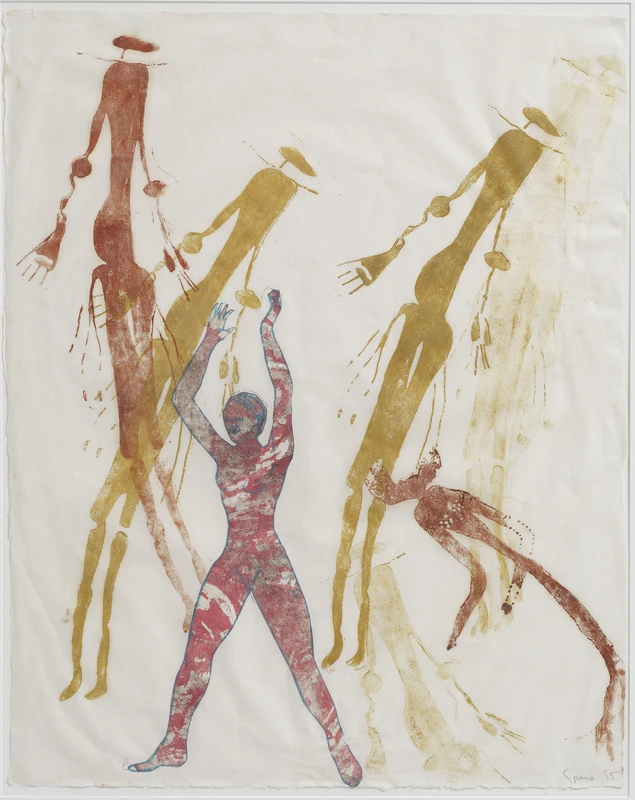Nancy Spero: Dancers & Goddesses
23 Sep-5 Nov 2022
PV 22 Sep 2022, 6-8pm


Frith Street Gallery is pleased to present Dancers & Goddesses, the gallery’s first exhibition representing the Estate of Nancy Spero (1926–2009)
Focussing on a particularly productive time for the artist, 1984–96, Dancers & Goddesses shows the dynamic range of Spero’s ‘pantheon’ of figures, including athletes, mourners, dancers and goddesses.
After spending the early 1960s in Paris, where she made her series of Paris Black Paintings, Spero returned to New York in 1964 amid the unrest of the Vietnam War. Rejecting paint-on-canvas as ‘too heroic’, Spero devoted the rest of her life to working on paper, starting with the War Series (1966–70), paintings that confronted American aggression in Vietnam. She then worked on the Artaud Paintings (1969–70) and Codex Artaud (1971–72), tapping into the rage of the French poet Antonin Artaud (1896–1948) by integrating snippets of his poetry into her work. Notes in Time (1979), now in MoMA’s collection, marked one of the last works where she used language as a core medium. In the 1980s, she believed that the images could provide her with a hieroglyphic language, and she developed her own lexicon of ‘woman as protagonist and hero’: about 400 images of women, drawn from across art history, media and mythology, which she used and reused over the next three decades. With her cast of women from all walks of life, Spero wanted to reverse the tradition of portraying men as heroes: ‘I articulate women’s situation and actions from repressed, victimized states to buoyant, self-confident stances.’
In Goddess and Dancing Figures (1985) a group of orange and ochre dancers, images derived from prehistoric paintings, appear in the same picture as a ‘goddess’ who could be from the present-day. ‘I combine in one work’, wrote the artist in 1985, ‘figures derived from various cultures whose extremely diverse and often disproportionate body sizes and types coexist in simultaneous time.’ The two-part work Picasso and Fredericks’ of Hollywood (1990) typifies Spero’s description of this method. A lingerie-clad woman from a Frederick’s of Hollywood ad, a Mexican figurine depicting a birth, and a woman’s body given a Cubist treatment by Picasso, among others, all occupy the same space. Each of these figures are deployed more than once, in colours that shift in tone from celebratory to absurd, even satirical. In Athena and Chorus (1995), the central figure of Athena, a goddess associated with wisdom, war and the arts, stands against the background of a grid dominated by shades of red. The chorus appears in the form of disembodied heads, with their long tongues extended, possibly singing her praises, or warding off evil. Spero developed the image of the head with the extended tongue while making the Codex Artaud and reused it frequently in her work. The background, a vivid, multi-coloured grid, conveys a forceful intensity, and may in part allude to the tenets of Greenbergian modernism, subverted here by Spero with the presence of an ancient goddess.
Nancy Spero and Leon Golub are the subject of a display at Tate Modern until spring 2023.
Dancers & Goddesses is organised in collaboration with Galerie Lelong & Co. and the Spero Golub Foundation.
Nancy Spero: Dancers & Goddesses | Press Release
Download